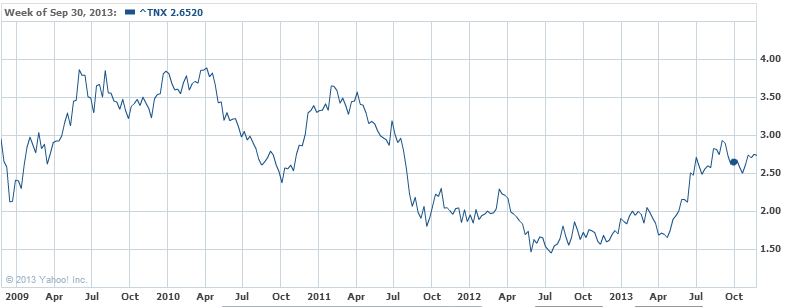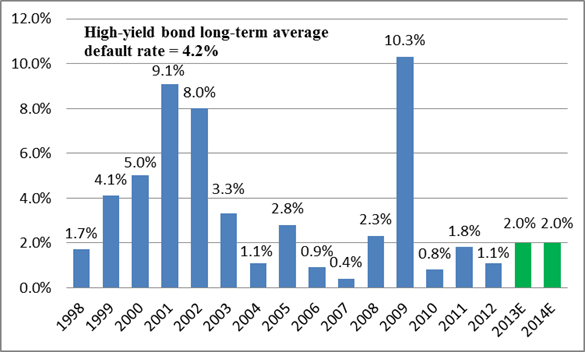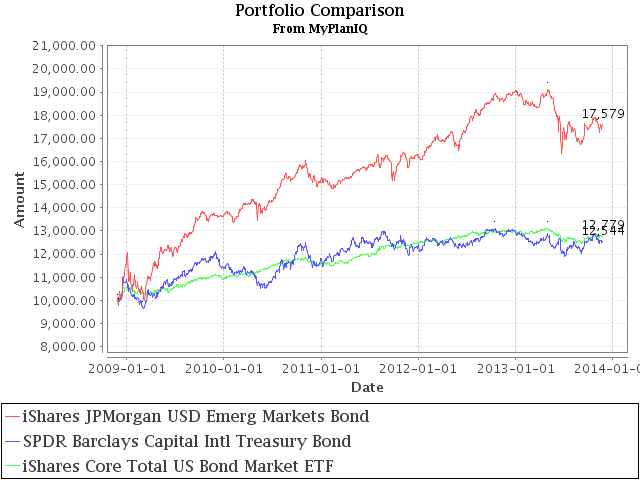Re-balance Cycle Reminder All MyPlanIQ’s newsletters are archived here.
For regular SAA and TAA portfolios, the next re-balance will be on Monday, December 9, 2013. You can also find the re-balance calendar for 2013 on ‘Dashboard‘ page once you log in.
As a reminder to expert users: advanced portfolios are still re-balanced based on their original re-balance schedules and they are not the same as those used in Strategic and Tactical Asset Allocation (SAA and TAA) portfolios of a plan.
Please note that we now list the next re-balance date on every portfolio page.
Downtrend of Bond Market in Place But Will It Continue?
2013 so far has been unfriendly to fixed income (bond) investors. The following shows how top mutual funds in intermediate bond category have performed:
| Ticker/Portfolio Name | YTD Return** |
1Yr AR | 3Yr AR | 5Yr AR | 10Yr AR |
|---|---|---|---|---|---|
| PTTRX (PIMCO Total Return Instl) | -1.1% | -0.1% | 4.1% | 8.2% | 6.2% |
| DLTNX (DoubleLine Total Return Bond N) | 0.5% | 0.9% | 5.4% | ||
| LSBRX (Loomis Sayles Bond Retail) | 4.7% | 7.4% | 7.6% | 16.0% | 7.8% |
| TGLMX (TCW Total Return Bond I) | 2.2% | 3.0% | 5.9% | 9.3% | 7.0% |
| MWTRX (Metropolitan West Total Return Bond M) | 0.5% | 1.4% | 5.1% | 10.1% | 6.4% |
| WAPIX (Western Asset Core Bond FI) | -1.8% | -1.5% | 3.8% | 11.2% | 4.3% |
| DODIX (Dodge & Cox Income) | 0.5% | 0.9% | 4.3% | 8.6% | 5.2% |
| FPNIX (FPA New Income) | 0.8% | 1.1% | 1.7% | 2.3% | 3.2% |
| PBDDX (PIMCO Investment Grade Corp Bd D) | -1.6% | -0.2% | 5.7% | 11.2% | |
| VBMFX (Vanguard Total Bond Market Index Inv) | -1.8% | -1.7% | 2.9% | 5.4% | 4.5% |
These mutual funds are managed by those who have won Morningstar’s managers of the year award in fixed income area. They are from P Bond Funds Momentum Based on Upgrading Fixed Income Managers of the Year`s Funds Quarterly.
Here are the trend scores for various bond segments:
Fixed Income Assets Trend Ranking
11/25/2013
| Description | Symbol | 1 Week | 4 Weeks | 13 Weeks | 26 Weeks | 52 Weeks | Trend Score |
|---|---|---|---|---|---|---|---|
| High Yield | JNK | 0.43% | 0.36% | 4.16% | 1.57% | 7.7% | 2.85% |
| Short Term Credit | CSJ | 0.02% | 0.13% | 0.72% | 0.53% | 1.36% | 0.55% |
| Intermediate Term Credit | CIU | -0.06% | 0.0% | 2.02% | -0.74% | 0.35% | 0.32% |
| Short Term Treasury | SHY | 0.0% | 0.08% | 0.39% | 0.27% | 0.43% | 0.23% |
| Treasury Bills | SHV | 0.0% | 0.01% | 0.0% | 0.0% | 0.03% | 0.01% |
| MBS Bond | MBB | -0.41% | -0.62% | 1.89% | -0.56% | -1.02% | -0.14% |
| International Treasury | BWX | -0.43% | -2.5% | 2.2% | 1.61% | -2.79% | -0.38% |
| US Total Bond | BND | -0.17% | -0.36% | 1.7% | -1.22% | -2.12% | -0.43% |
| Long Term Credit | LQD | -0.06% | -0.48% | 2.84% | -2.32% | -2.56% | -0.52% |
| California Muni | CMF | -0.25% | -0.43% | 4.72% | -3.12% | -4.03% | -0.62% |
| New York Muni | NYF | -0.23% | -0.53% | 4.5% | -3.83% | -4.95% | -1.01% |
| International Inflation Protected | WIP | -0.24% | -3.01% | 2.88% | -2.28% | -2.57% | -1.04% |
| National Muni | MUB | -0.24% | -0.32% | 3.37% | -3.98% | -5.06% | -1.25% |
| Intermediate Treasury | IEF | -0.47% | -1.05% | 1.88% | -3.54% | -4.5% | -1.54% |
| Inflation Protected | TIP | -0.5% | -1.16% | 1.12% | -4.65% | -7.11% | -2.46% |
| 10-20Year Treasury | TLH | -0.83% | -1.94% | 1.1% | -5.47% | -7.71% | -2.97% |
| Emerging Mkt Bonds | PCY | -0.37% | -2.42% | 3.26% | -6.76% | -9.08% | -3.07% |
| 20+ Year Treasury | TLT | -1.09% | -3.18% | 0.23% | -9.41% | -14.12% | -5.51% |
Readers can find this info on 360° Market Overview page.
From the above table, one can see that other than high yield bonds and short term bonds, virtually all other bonds have a negative 52 week return. This trend ranking has been more or less like this since May this year.
General trend and Treasury bonds
Since the talk of tapering QE (Quantitative Easing) program began in September, bond markets have reacted accordingly. It is pretty obvious that if one of the big buyers (the Federal Reserve) stops or decreases its monthly $85 billion purchases of mortgage securities and Treasurys between four and 30 years, these rates will go up.
The question is how much and for how long?
No one knows. For one, we know that if long term Treasury rates go up too much, it will directly affect housing mortgage rates and that in terms will seriously have an impact on housing market recovery. That in terms will affect the general economic activities and eventually derail the current stock market rally (remember that the current record high corporate profit margin is because of excessive household and government debts, see Hussman’s latest comments). When that happens, bond markets can stop to breath a bit or keep going down (for example, due to Fed’s over tapering or tightening), along with the stock market. The latter scenario is the worst nightmare for current investors: when that happens, you have nowhere to hide. Worse, you have no indication from bond markets to help to position (i.e. reduce) your allocation in stocks.
On the other hand, the current weakness of bond markets has been mild: in fact, the 10 year Treasury note’s rate was above 3% before the QE3 was announced in September. Today it is still 2.74%:
In general, we don’t see that the Fed wants to taper its QE program dramatically. However, whether that can convince bond investors or not is another story.
In the following, we review various bond segments.
High yield bonds
From the above table, one can see that high yield bonds have been the only bright stars that still deliver respectable returns. Based on Fitch the U.S. high yield bond default rate might be around 2-3% in 2013. The following chart is from Lord Abbett on high yield bond historical default rate:
Assuming the Fed’s loose monetary policy continues, high yield bonds will be still good investments. However, this asset class lies on the other end of risk spectrum in bonds: it is somewhat more correlated to stocks than general bonds. Nevertheless, this is one area that bond investors can still make money (with higher risk), as evidenced by the investments of the star performer this year among those total return bond funds: LSBRX (Loomis Sayles Bond Retail) was mostly in high yield bonds this year to earn its good return.
However, we don’t advocate buy and hold high yield bonds, or at least not at a significant allocation. One way is to invest in a total return bond fund upgrade portfolio listed on Fixed Income Bond Fund Portfolios. In this way, you invest in a good total return bond fund that invests in high yield bonds or other bonds smartly. The other way is to adopt a more active way to capture high yield bond momentum (high yield bonds have one of the best momentum tendency among all asset classes) by investing a portfolio like P High Yield Bond Alpha VWEHX (this portfolio is not really investable so you would need to use ETFs to replace the underlying fund VWEHX). However, this is an advanced portfolio that is not suitable to many investors.
Foreign and emerging market bonds
Investing in foreign and emerging market bonds in the past had been very profitable. This is because before the 2008 crisis, US dollars have gradually declined while globalization made both Euro area and emerging markets booming. This is no longer the case, at least not in the near term.
The reason is that when US QE starts to taper or decrease, US Treasury interest rates will rise and thus in general, US dollar’s value will rise against other currencies. This in effect will reverse international money flow and investors will withdraw from emerging and foreign currencies and invest in dollar assets instead. That in turn will drive down foreign bond values. This has been and will be one of the major determining factors for the prices of foreign bonds.
The other reason is that as bad as the US adopts loose monetary policy (which is still debatable), all other major economic regions including Eurozone, Japan, emerging markets (including China and Brazil) have adopted similar or even worse monetary stimulus. In general, we view emerging markets will have much harder time to deal with monetary tightening, especially when US reverses its course.
What the above reasoning tells us is that one should be especially cautious on foreign and emerging market bonds in the coming years. There is no sure bet here and there is no sure secular trend one can spot out right now.
The takeaway from the above discussion is that investing in fixed income is no longer a slam dunk or sure way to make money. However, from time to time, there will be opportunities that are present. Managing this tactically is the best way.
Portfolio Performance Review
As US stocks continue to do well, we have been asked and compared with US stock-centric portfolios. Here are several sector and style US stock ETF portfolios we mentioned in the previous newsletter April 1, 2013: Momentum Over Stocks, Sector And Style Funds.
Portfolio Performance Comparison (as of 11/25/2013)
| Ticker/Portfolio Name | YTD Return** |
1Yr AR | 3Yr AR | 3Yr Sharpe | 5Yr AR | 5Yr Sharpe | 10Yr AR | 10Yr Sharpe |
|---|---|---|---|---|---|---|---|---|
| P Momentum Scoring Sector ETFs | 25.6% | 28.8% | 13.0% | 0.78 | 10.7% | 0.54 | 9.9% | 0.44 |
| P Momentum Scoring Style ETFs | 33.7% | 37.8% | 17.4% | 0.93 | 22.0% | 0.94 | 8.4% | 0.32 |
| P Momentum Scoring Style ETFs and Treasuries | 34.1% | 39.8% | 15.2% | 0.95 | 13.4% | 0.78 | 11.9% | 0.7 |
| SPY (SPDR S&P 500) | 28.8% | 32.5% | 17.0% | 1.02 | 20.4% | 1 | 7.8% | 0.33 |
**YTD: Year to Date
P Momentum Scoring Sector ETFs and P Momentum Scoring Style ETFs are relative strength based. They invest in top sectors or top style ETFs each month. Even when stock markets are not doing well, they will not go to cash or invest in bonds. On the contrary, P Momentum Scoring Style ETFs and Treasuries can invest in short or intermediate term Treasury ETFs (SHY or IEI) when stock markets are in downtrend. One can see all of these portfolios beat SPY in the 10 year time frame. In particular, the ‘absolute’ momentum based P Momentum Scoring Style ETFs and Treasuries did the best in the last 10 years. They all deliver reasonable performance YTD with both style portfolios outperforming S&P 500 SPY.
Market Overview
As we are approaching Thanksgiving holiday in the U.S., we have plenty to thank for, especially for the recent stock market strength. However, investors should become more worried as stock markets are rising, especially at such an elevated level. In addition to the weakness in bonds, the weakness in emerging market stocks and REITs continue to draw our attention. For more detailed, please refer to 360° Market Overview.
We would like to remind our readers that markets are more precarious now than other times in the last 5 years. It is a good time and imperative to adjust to a risk level you are comfortable with right now. However, recognizing our deficiency to predict the markets, we will stay on course.
We again copy our position statements (from previous newsletters):
Our position has not changed: We still maintain our cautious attitude to the recent stock market strength. Again, we have not seen any meaningful or substantial structural change in the U.S., European and emerging market economies. However, we will let markets sort this out and will try to take advantage over its irrational behavior if it is possible.
We again would like to stress for any new investor and new money, the best way to step into this kind of markets is through dollar cost average (DCA), i.e. invest and/or follow a model portfolio in several phases (such as 2 or 3 months) instead of the whole sum at one shot.
Latest Articles
- A Reminder About Real Return
- Fidelity Commission Free ETFs
- Sector Investments: Cyclical Sectors On Top
- Choosing an index fund when the indexes are sky-high
- Housing Market Picking Up and Interest Rates Rising
- Stock Market Sentiment Review
- Diversification doesn’t help this year: global diversified portfolios lag simple US balance funds
- Reflate a housing bubble
- November 18, 2013: Review of Permanent, Closed End Fund and Income Portfolios
- Two Good Risk Parity Mutual Funds
Enjoy Newsletter
How can we improve this newsletter? Please take our survey
–Thanks to those who have already contributed — we appreciate it.





 Diversified Asset Allocation Portfolios For Your Plans
Diversified Asset Allocation Portfolios For Your Plans
